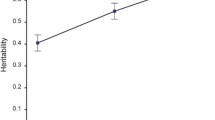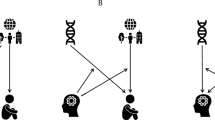Abstract
Measures of intelligence were collected in 209 twin pairs at 5, 7, 10, and 12 years of age, as part of a longitudinal project on intelligence, brain function, and behavioral problems. Intelligence was measured at 5, 7, and 10 years of age with the RAKIT, a well-known Dutch intelligence test, consisting of 6 subscales. At 12 years of age, the complete WISC-R was administered (12 subscales). Both intelligence tests resulted in a measure of full-scale IQ (FSIQ). Participation rate is around 93% at age 12. Correlation coefficients over time are high: (r(5–7) = .65; r(5–10) = .65; r(5–12) = .64; r(7–10) = .72; r(7–12) = .69 and r(10–12) = .78). Genetic analyses show significant heritabilities at all ages, with the expected increase of genetic influences and decrease of shared environmental influences over the years. Genetic influences seem to be the main driving force behind continuity in general cognitive ability, represented by a common factor influencing FSIQ at all ages. Shared environmental influences are responsible for stability as well as change in the development of cognitive abilities, represented by a common factor influencing FSIQ at all ages and age-specific influences, respectively.
Similar content being viewed by others
REFERENCES
Alarcón, M., Plomin, R., Fulker, D. W., Corley, R., and DeFries, J. C. (1998). Multivariate path analysis of specific cognitive abilities data at 12 years of age in the Colorado Adoption Project. Behav. Genet. 28:255–264.
Alarcón, M., Plomin, R., Fulker, D. W., Corley, R., and DeFries, J. C. (1999). Molarity not modularity: Multivariate genetic analysis of specific cognitive abilities in parents and their 16-year-old children in the Colorado Adoption Project. Cog. Dev. 14:175–193.
Benson, J. B., Cherny, S. S., Haith, M. M., and Fulker, D. W. (1993). Rapid assessment of infant predictors of adult IQ: Midtwinmidparent analyses. Dev. Psychol. 29:434–447.
Bleichrodt, N., Drenth, P. J. D., Zaal, J. N., and Resing, W. C. M. (1984). Revisie Amsterdamse Kinder Intelligentie Test [Revised Amsterdam Child Intelligence Test]. Swets and Zeitlinger B. V., Lisse, The Netherlands.
Boomsma, D. I., Orlebeke, J. F., and Van Baal, G. C. M. (1992). The Dutch Twin Register: Growth data on weight and height. Behav. Genet. 22:247–251.
Boomsma, D. I., and Molenaar, P. C. (1987). The genetic analysis of repeated measures. I. Simplex models. Behav. Genet. 17(2):111–123.
Boomsma, D. I. (1993). Current status and future prospects in twin studies of the development of cognitive abilities: Infancy to old age. In Bouchard, T. J. Jr, Propping, P. (Ed.), Twins as a Tool of Behavioral Genetics. John Wiley & Sons Ltd., pp. 67–82.
Boomsma, D. I., and Van Baal, G. C. M. (1998). Genetic influences on childhood IQ in 5-and 7-year-old Dutch twins. Dev. Neuropsychol. 14:115–126.
Bouchard, T. J., Jr. (1981). Galton Lecture: Behaviour genetic studies of intelligence, yesterday and today: The long journey from plausibility to proof. J. Biosoc. Sci. 28:527–555.
Bouchard, T. J. Jr., and McGue, M. (1981). Familial studies of intelligence: a review. Science 212:1055–1059.
Bratko, D. (1996). Twin study of verbal and spatial abilities. Personal and Individual Differences 21:621–624.
Cardon, L. R., and Fulker, D. W. (1994). A model of developmental change in hierarchical phenotypes with application to specific cognitive abilities. Behav. Genet 24:1–16.
Cardon, L. R., Fulker, D. W., DeFries, J. C. and Plomin, R. (1992). Continuity and change in general cognitive ability From 1 to 7 years of age. Dev. Psychol. 28:1–10.
Cherny, S. S., and Cardon, L. R. (1994). General cognitive ability. In DeFries, J. C., Plomin, R. and Fulker, D. W. (eds.), Nature and Nurture During Middle Childhood. Blackwell, Oxford, England, Ch. 4.
DeFries, J. C., Plomin, R., and LaBuda, M. C. (1987). Genetic stability of cognitive development from childhood to adulthood. Dev. Psychol. 23:4–12.
DiLalla, L. F., Thompson, L. A., Plomin, R., Phillips, K., Fagan III, J. F., and Haith, M. M. (1990). Infant predictors of preschool and adult IQ: A study of infant twins and their parents. Dev. Psychol. 26:759–769.
Eaves, L. J., Long, J., and Heath, A. C. (1986). A theory of developmental change in quantitative phenotypes applied to cognitive development. Behav. Genet. 16:143–162.
Fulker, D. W., Cherny, S. S., and Cardon, L. R. (1993). Continuity and change in cognitive development. In Plomin, R., and Mc-Clearn, G. E. (eds.), Nature, Nurture and Psychology. American Psychological Association, Washington, D.C., pp. 77–97.
Fulker, D. W., DeFries, J. C., and Plomin, R. (1988). Genetic influence on general mental ability increases between infancy and middle childhood. Nature 336:767–769.
Guttman, L. (1954). A new approch to factor analysis: The radax. In Lazarsfeld, P. F. (ed.), Mathematical Thinking in the Social Sciences. Free Press, Glencoe, IL, pp. 258–349.
Humphreys, L. G., and Davey, T. C. (1988). Continuity in intellectual growth from 12 months to 9 years. Intelligence 12:183–197.
LaBuda, M. C., DeFries, J. C., Plomin, R., and Fulker, D. W. (1986). Longitudinal stability of cognitive ability from infancy to early childhood: Genetic and environmental etiologies. Child Dev. 57:1142–1150.
Loehlin, J. C., Horn, J. M., and Willerman, L. (1989). Modeling IQ change: Evidence from the Texas Adoption Project. Child Dev. 60:993–1004.
McCartney, K., Harris, M. J., and Bernieri, F. (1990). Growing up and growing apart: A developmental meta-analysis of twin studies. Psychol. Bull. 107:226–237.
McGue, M., Bouchard, T. J., Iacono, W. G., and Lykken, D. T. (1993). Behavioral genetics of cognitive ability: A life-span perspective. In Plomin, R., and McClearn, G. E. (eds.), Nature, nurture and psychology. American Psychology Association, Washington, D.C., pp. 59–76.
Neale, M. C., Boker, S. M., Xie, G., and Maes, H. H. (1999). Mx: Statistical Modeling, 5th ed. Box 126 MCV, Richmond, VA 23298: Department of Psychiatry. Patrick, C. L. (2000). Genetic and environmental influences on the development of cognitive abilities: Evidence from the field of developmental behavior genetics. J. School Psychol. 38:79–108.
Phillips, K., and Fulker, D. W. (1989). Quantitative genetic analysis of longitudinal trends in adoption designs with application to IQ in the Colorado Adoption Project. Behav. Genet. 19:621–658.
Pijl, Y. J., Hofman, R. H., Bleichrodt, N., Resing, W. C. M., Lutje-Spelberg, H., Bruijn, E., de, and Zaal, J. N. (1984). Vergelijkbaarheid van de WISC-R en RAKIT. Research Instituut voor Onderwijs in het Noorden, Vrije Universiteit., Amsterdam.
Plomin, R., Campos, J., Corley, R., Emde, R. N., Fulker, D. W., Kagan, J., Reznick, J. S., Robinson, J., Zahn-Waxler, C., and De-Fries, J. C. (1990). Individual differences during the second year of life: The MacArthur Longitudinal Twin Study. In Columbo, J., and Fagan, J. (eds.), Individual Differences in Infancy: Reliability, Stability, and Predictability. Hillsdale, New York.
Plomin, R., and DeFries, J. C. (1983). The Colorado Adoption Project. Child Dev. 54:276–289.
Plomin, R., and DeFries, J. C. (1985). Origins of individual differences in infancy. In Plomin, R., and DeFries, J. C. (eds.), Ori-gins of Individual Differences in Infancy, Orlando, pp. 48–64, 90–127.
Plomin, R., Emde, R. N., Braungart, J. M., Campos, J., Corley, R., Fulker, D. W., Kagan, J., Reznick, J. S., Robinson, J., and Zahn-Waxler, C. (1993). Genetic change and continuity from fourteen to twenty months: The MacArthur Longitudinal Twin Study. Child Dev. 64:1354–1376.
Plomin, R., Fulker, D. W., Corley, R., and DeFries. J. C. (1997). Nature, nurture, and cognitive development from 1 to 16 years: A parent-offspring adoption study. Psychol. Sci. 8:442–447.
Posthuma, D., De Geus, E. J., Bleichrodt, N., and Boomsma, D. I. (2000). Twin-singleton differences in intelligence?, Twin Res. 3(2):83–87.
Rietveld, M. J. H., Van Baal, G. C. M., Dolan C. V., and Boomsma, D. I. (2000). Genetic factor analyses of specific cognitive abilities in 5-year-old Dutch children. Behav. Genet. 30(1):29–40.
Rietveld, M. J. H., Dolan, C. V., Van Baal, G. C. M., and Boomsma, D. I. (submitted). A twin study of differentiation of cognitive abilities in childhood.
Rijsdijk, F. V., and Boomsma, D. I. (1997). Genetic mediation of the correlation between peripheral nerve conduction velocity and IQ. Behav. Genet. 27(2):87–98.
Rijsdijk, F. V., Vernon, P. A., and Boomsma, D. I. (1998). The genetic basis of the relation between speed-of-information-processing and IQ. Behav. Brain Res. 95(1):77–84.
Skodak, M., and Skeels, H. M. (1949). A final follow-up of one hundred adopted children. J. Genet. Psychol. 75:85–125.
Thompson, L. A. (1993). Genetic contributions to intellectual development in infancy and childhood. In Vernon, P. A. (ed.), Biological Approaches to the Study of Human Intelligence, pp. 95–138.
Van Haasen, P. P., De Bruyn, E. E. J., Pijl, Y. J., Poortinga, Y. H., Lutje-Spelberg, H. C., Vander Steene, G., Coetsier, P., Spoelders-Claes, R., and Stinissen, J. (1986). Wechsler Intelligence Scale for Children-Revised, Dutch Version. Swets & Zetlinger B. V., Lisse, The Netherlands.
Wilson, R. S. (1993). The Louisville Twin Study: Developmental synchronies in behavior. Child Dev. 54:298–316.
Author information
Authors and Affiliations
Corresponding author
Rights and permissions
About this article
Cite this article
Bartels, M., Rietveld, M.J.H., Van Baal, G.C.M. et al. Genetic and Environmental Influences on the Development of Intelligence. Behav Genet 32, 237–249 (2002). https://doi.org/10.1023/A:1019772628912
Issue Date:
DOI: https://doi.org/10.1023/A:1019772628912




